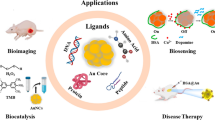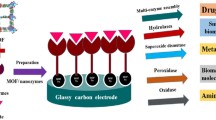Abstract
MicroRNAs can serve as biomarkers for many cancers, so it is significant to develop simple and sensitive strategies for microRNAs detection. Photoelectrochemical (PEC) detection has the advantages of simple equipment and high sensitivity. But in conventional PEC DNA sensors, tedious immobilization procedures of photoactive materials and capture probes on electrode surfaces are inevitable. To overcome those limitations, a homogeneous PEC biosensor based on target-responsive hydrogels has been developed (miRNA-155 has been chosen as a model target). PEC signal molecules (TiO2 nanoparticles, TiO2 NPs) were embedded in DNA hydrogels formed by hyaluronic acid sodium salt, amine-modified DNA double strands, and polyethylenimine rich in amine groups. In the presence of the target, DNA double strands in hydrogel were nicked by endonuclease and TiO2 NPs were released to the supernate and a high PEC response was obtained when collecting the supernate for PEC test, while almost no TiO2 NPs released in the absence of the target. Thanks to the exonuclease III and nicking endonuclease Nb.BbvCI-assisted cascaded amplification strategy, the proposed biosensor exhibits high sensitivity toward miRNA-155 with a low detection limit of 0.41 fM and a wide linear range from 1.0 fM to 100 pM. Since this method circumvents tedious electrode modification procedures, the proposed technique exhibits the advantages of simplicity and good reproducibility. Moreover, the prepared hydrogels have outstanding storage stability, so that they can be prepared in advance and shorten detection time. This biosensing platform provides a versatile strategy for the construction of homogeneous PEC biosensors for the detection of diverse targets.
Graphical abstract

Photoelectrochemical detection techniques have been coupled with controlled release system to develop an immobilization-free microRNA biosensor. High sensitivity has been realized based on cascaded signal amplification strategy, and the proposed biosensor has been applied to detect the target in real sample with satisfied results. Since no tedious electrode modifications, the proposed homogeneous PEC sensor exhibits high reproducibility and good stability.





Similar content being viewed by others
References
Lu J, Getz G, Miska EA, Alvarez-Saavedra E, Lamb J, Peck D, Sweet-Cordero A, Ebert BL, Mak RH, Ferrando AA, Downing JR, Jacks T, Horvitz HR, Golub TR (2005) MicroRNA expression profiles classify human cancers. Nature 435:834–838. https://doi.org/10.1038/nature03702
Calin GA, Croce CM (2006) MicroRNA signatures in human cancers. Nat Rev Cancer 6:857–866. https://doi.org/10.1038/nrc1997
Lu Y, Xiao J, Lin H, Bai Y, Luo X, Wang Z, Yang B (2009) A single anti-microRNA antisense oligodeoxyribonucleotide (AMO) targeting multiple microRNAs offers an improved approach for microRNA interference. Nucleic Acids Res 37:e24. https://doi.org/10.1093/nar/gkn1053
Li J, Yao B, Huang H, Wang Z, Sun C, Fan Y, Chang Q, Li S, Wang X, Xi J (2009) Real-time polymerase chain reaction microRNA detection based on enzymatic stem-loop probes ligation. Anal Chem 81:5446–5451. https://doi.org/10.1021/ac900598d
Valoczi A, Hornyik C, Varga N, Burgyan J, Kauppinen S, Havelda Z (2004) Sensitive and specific detection of microRNAs by northern blot analysis using LNA-modified oligonucleotide probes. Nucleic Acids Res 32:e175. https://doi.org/10.1093/nar/gnh171
Lim LP, Lau NC, Garrett-Engele P, Grimson A, Schelter JM, Castle J, Bartel DP, Linsley PS, Johnson JM (2005) Microarray analysis shows that some microRNAs downregulate large numbers of target mRNAs. Nature 433:769–773. https://doi.org/10.1038/nature03315
Fu N, Wang L, Zou X, Li C, Zhang S, Zhao B, Gao Y, Wang L (2020) A photoelectrochemical sensor based on a reliable basic photoactive matrix possessing good analytical performance for miRNA-21 detection. Analyst 145:7388–7396. https://doi.org/10.1039/d0an01297a
Yu LD, Wen YX, Zhang XY, Li NB, Luo HQ (2020) Signal-off photoelectrochemical determination of miRNA-21 using aptamer-modified In2O3@Cu2MoS4 nanocomposite. Mikrochim Acta 187:561. https://doi.org/10.1007/s00604-020-04540-z
Huang X, Liu Y, Yung B, Xiong Y, Chen X (2017) Nanotechnology-enhanced no-wash biosensors for in vitro diagnostics of cancer. ACS Nano 11:5238–5292. https://doi.org/10.1021/acsnano.7b02618
Hong Q, Ge L, Wang W, Liu X, Li F (2018) Oligonucleotide-modulated photocurrent enhancement of a tetracationic porphyrin for label-free homogeneous photoelectrochemical biosensing. Biosens Bioelectron 121:90–95. https://doi.org/10.1016/j.bios.2018.08.071
Hou T, Xu N, Wang W, Ge L, Li F (2018) Truly immobilization-free diffusivity-mediated photoelectrochemical biosensing strategy for facile and highly sensitive microRNA assay. Anal Chem 90:9591–9597. https://doi.org/10.1021/acs.analchem.8b02523
Song X, Hou T, Lu F, Wang Y, Liu J, Li F (2020) Homogeneous photoelectrochemical biosensing via synergy of G-quadruplex/hemin catalysed reactions and the inner filter effect. Chem Commun (Camb) 56:1811–1814. https://doi.org/10.1039/c9cc09280c
Wu J, Lv W, Yang Q, Li H, Li F (2021) Label-free homogeneous electrochemical detection of MicroRNA based on target-induced anti-shielding against the catalytic activity of two-dimension nanozyme. Biosens Bioelectron 171:112707. https://doi.org/10.1016/j.bios.2020.112707
Li H, Chang J, Gai P, Li F (2018) Label-free and ultrasensitive biomolecule detection based on aggregation induced emission fluorogen via target-triggered hemin/G-quadruplex-catalyzed oxidation reaction. ACS Appl Mater Interfaces 10:4561–4568. https://doi.org/10.1021/acsami.7b18676
Wu J, Yang Q, Li Q, Li H, Li F (2021) Two-dimensional MnO2 nanozyme-mediated homogeneous electrochemical detection of organophosphate pesticides without the interference of H2O2 and color. Anal Chem 93:4084–4091. https://doi.org/10.1021/acs.analchem.0c05257
Um SH, Lee JB, Park N, Kwon SY, Umbach CC, Luo D (2006) Enzyme-catalysed assembly of DNA hydrogel. Nat Mater 5:797–801. https://doi.org/10.1038/nmat1741
Miyata T, Jige M, Nakaminami T, Uragami T (2006) Tumor marker-responsive behavior of gels prepared by biomolecular imprinting. Proc Natl Acad Sci U S A 103:1190–1193. https://doi.org/10.1073/pnas.0506786103
Lin Y, Wang X, Sun Y, Dai Y, Sun W, Zhu X, Liu H, Han R, Gao D, Luo C (2019) A chemiluminescent biosensor for ultrasensitive detection of adenosine based on target-responsive DNA hydrogel with Au@HKUST-1 encapsulation. Sensors Actuators B Chem 289:56–64. https://doi.org/10.1016/j.snb.2019.03.075
He Y, Yang X, Yuan R, Chai Y (2017) Switchable target-responsive 3D DNA hydrogels as a signal amplification strategy combining with SERS technique for ultrasensitive detection of miRNA 155. Anal Chem 89:8538–8544. https://doi.org/10.1021/acs.analchem.7b02321
Yan L, Zhu Z, Zou Y, Huang Y, Liu D, Jia S, Xu D, Wu M, Zhou Y, Zhou S, Yang CJ (2013) Target-responsive “sweet” hydrogel with glucometer readout for portable and quantitative detection of non-glucose targets. J Am Chem Soc 135:3748–3751. https://doi.org/10.1021/ja3114714
Tan B, Zhao H, Du L, Gan X, Quan X (2016) A versatile fluorescent biosensor based on target-responsive graphene oxide hydrogel for antibiotic detection. Biosens Bioelectron 83:267–273. https://doi.org/10.1016/j.bios.2016.04.065
Liu D, Jia S, Zhang H, Ma Y, Guan Z, Li J, Zhu Z, Ji T, Yang CJ (2017) Integrating target-responsive hydrogel with pressuremeter readout enables simple, sensitive, user-friendly, quantitative point-of-care testing. ACS Appl Mater Interfaces 9:22252–22258. https://doi.org/10.1021/acsami.7b05531
Zhu Z, Guan Z, Jia S, Lei Z, Lin S, Zhang H, Ma Y, Tian ZQ, Yang CJ (2014) Au@Pt nanoparticle encapsulated target-responsive hydrogel with volumetric bar-chart chip readout for quantitative point-of-care testing. Angew Chem Int Ed Engl 53:12503–12507. https://doi.org/10.1002/anie.201405995
Zhao M, Wang P, Guo Y, Wang L, Luo F, Qiu B, Guo L, Su X, Lin Z, Chen G (2018) Detection of aflatoxin B1 in food samples based on target-responsive aptamer-cross-linked hydrogel using a handheld pH meter as readout. Talanta 176:34–39. https://doi.org/10.1016/j.talanta.2017.08.006
Li Z, Zhang J, Chen H, Huang X, Huang D, Luo F, Wang J, Guo L, Qiu B, Lin Z (2019) Electrochemiluminescence biosensor for hyaluronidase based on the Ru(bpy)32+ doped SiO2 nanoparticles embedded in the hydrogel fabricated by hyaluronic acid and polyethylenimine. ACS Applied Bio Materials 3:1158–1164. https://doi.org/10.1021/acsabm.9b01082
Huang Y, Ma Y, Chen Y, Wu X, Fang L, Zhu Z, Yang CJ (2014) Target-responsive DNAzyme cross-linked hydrogel for visual quantitative detection of lead. Anal Chem 86:11434–11439. https://doi.org/10.1021/ac503540q
Wang J, Hui N (2019) Electrochemical functionalization of polypyrrole nanowires for the development of ultrasensitive biosensors for detecting microRNA. Sensors Actuators B Chem 281:478–485. https://doi.org/10.1016/j.snb.2018.10.131
Ren R, Bi Q, Yuan R, Xiang Y (2020) An efficient, label-free and sensitive electrochemical microRNA sensor based on target-initiated catalytic hairpin assembly of trivalent DNAzyme junctions. Sensors and Actuators B-Chemical 304. https://doi.org/10.1016/j.snb.2019.127068
Zhu HY, Ding SN (2019) Dual-signal-amplified electrochemiluminescence biosensor for microRNA detection by coupling cyclic enzyme with CdTe QDs aggregate as luminophor. Biosens Bioelectron 134:109–116. https://doi.org/10.1016/j.bios.2019.04.005
Kerr E, Farr R, Doeven EH, Nai YH, Alexander R, Guijt RM, Prieto-Simon B, Francis PS, Dearnley M, Hayne DJ, Henderson LC, Voelcker NH (2021) Amplification-free electrochemiluminescence molecular beacon-based microRNA sensing using a mobile phone for detection. Sensors Actuators B Chem 330:129261. https://doi.org/10.1016/j.snb.2020.129261
Yi W, Cai R, Xiang D, Wang Y, Zhang M, Ma Q, Cui Y, Bian X (2019) A novel photoelectrochemical strategy based on an integrative photoactive heterojunction nanomaterial and a redox cycling amplification system for ultrasensitive determination of microRNA in cells. Biosens Bioelectron 143:111614. https://doi.org/10.1016/j.bios.2019.111614
Li L, Zhang Y, Yan Z, Chen M, Zhang L, Zhao P, Yu J (2020) Ultrasensitive photoelectrochemical detection of microRNA on paper by combining a cascade nanozyme-engineered biocatalytic precipitation reaction and target-triggerable DNA motor. ACS Sensors 5:1482–1490. https://doi.org/10.1021/acssensors.0c00632
Funding
This project was financially supported by the National Key Research and Development Program of China (No. 2019YFC1604701), National Sciences Foundation of China (21974020, 21775026) and the cooperative project of production and study in University of Fujian Province (2018Y4007), the Sciences Foundation of Fujian Province (2018 J01685, 2018J01682), and the United Fujian Provincial Health and Education Project for Tackling the Key Research P. R. China (2019-WJ-11).
Author information
Authors and Affiliations
Corresponding authors
Ethics declarations
Conflict of interest
The authors declare no competing interests.
Additional information
Publisher’s note
Springer Nature remains neutral with regard to jurisdictional claims in published maps and institutional affiliations.
Supplementary information
ESM 1
(DOCX 1482 kb)
Rights and permissions
About this article
Cite this article
Yang, J., Fu, S., Luo, F. et al. Homogeneous photoelectrochemical biosensor for microRNA based on target-responsive hydrogel coupled with exonuclease III and nicking endonuclease Nb.BbvCI assistant cascaded amplification strategy. Microchim Acta 188, 267 (2021). https://doi.org/10.1007/s00604-021-04935-6
Received:
Accepted:
Published:
DOI: https://doi.org/10.1007/s00604-021-04935-6




